Learn how to make Katsuo Dashi, a Japanese soup stock made from dried bonito flakes. With its savory and distinct umami aroma, this stock is a game changer in your Japanese cooking. It can turn a lackluster ramen bowl into something extraordinary!
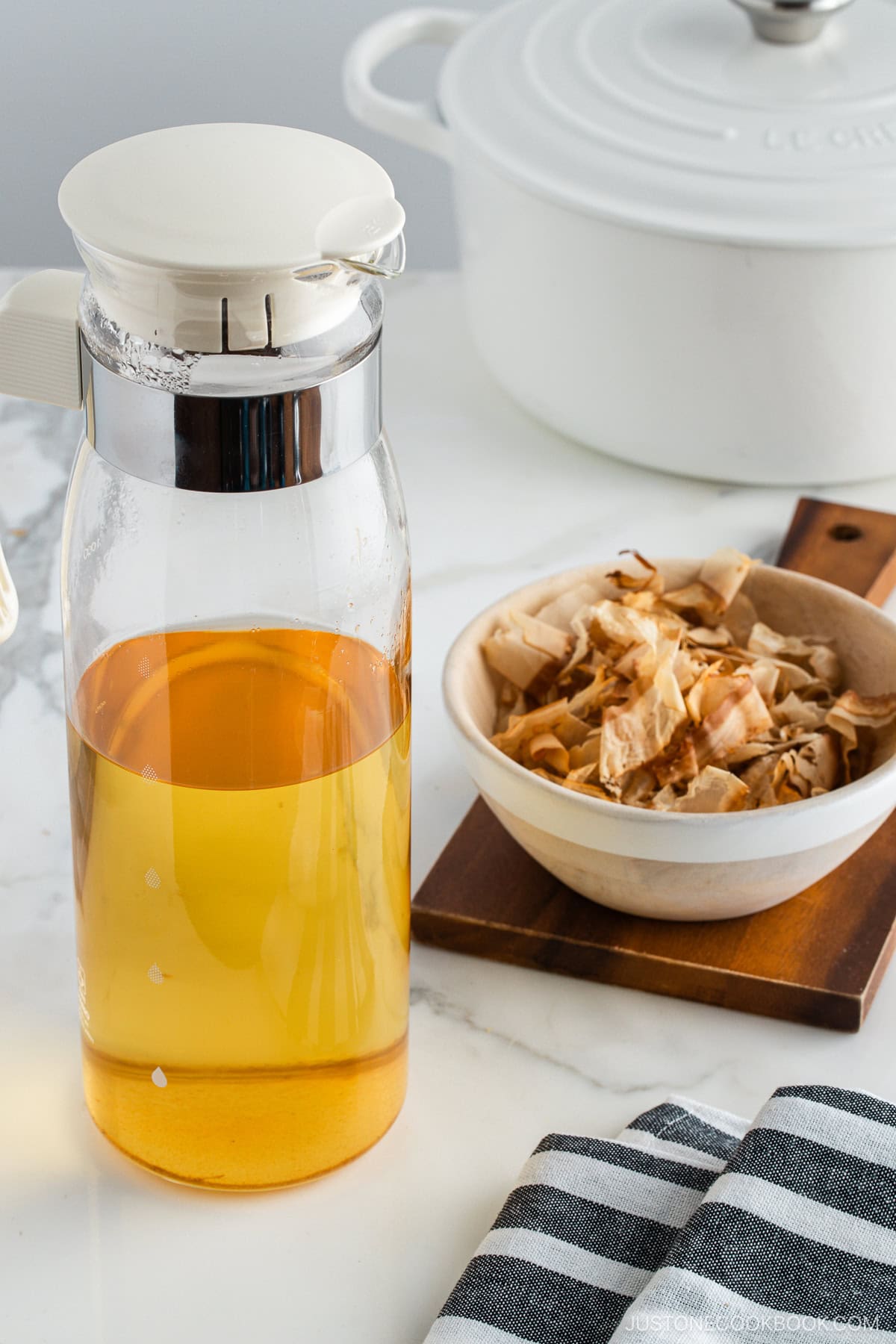
There are numerous methods and ingredients for making dashi, the Japanese soup stock that lays the foundation for many dishes in Japanese cuisine. I’ve shared many recipes for making different types of dashi (including vegetarian versions), but today I want to share how to make Katsuo Dashi (かつおだし).
Table of Contents
What is Katsuo Dashi?
Katsuo dashi (かつおだし) is made from katsuobushi (かつおぶし, 鰹節), dried and fermented bonito/skipjack tuna that is shaved into thin flakes. In Japanese cooking, the distinct umami taste from katsuobushi plays an important role in heightening flavor and aroma.
Unlike other dashi ingredients such as kombu, iriko/niboshi (dried sardine/anchovy), and shiitake mushrooms, katsuobushi does not need soaking before making delicious dashi. In other words, you can start making katsuo dashi right away, and it takes less than 15 minutes to make a rich and savory soup stock.
How to Make Katsuo Dashi
Just like other types of Japanese dashi broth, katsuo dashi is so easy to make from scratch. Here’s a quick overview; find the full instructions in my recipe card below.
- Bring the water to a near boil.
- Add katsuobushi shavings to the water. Bring it to a boil, reduce the heat, and simmer for 30 seconds. Turn off the heat.
- Let it sink in the pot or saucepan. Strain through a fine-mesh strainer.
Just like that, you have beautiful, golden katsuo dashi! You can store the dashi in an airtight container like a bottle or mason jar. Keep in the refrigerator for 3–5 days or in the freezer for 2 weeks.
Reserve the used katsuobushi to make furikake (Japanese rice seasoning).
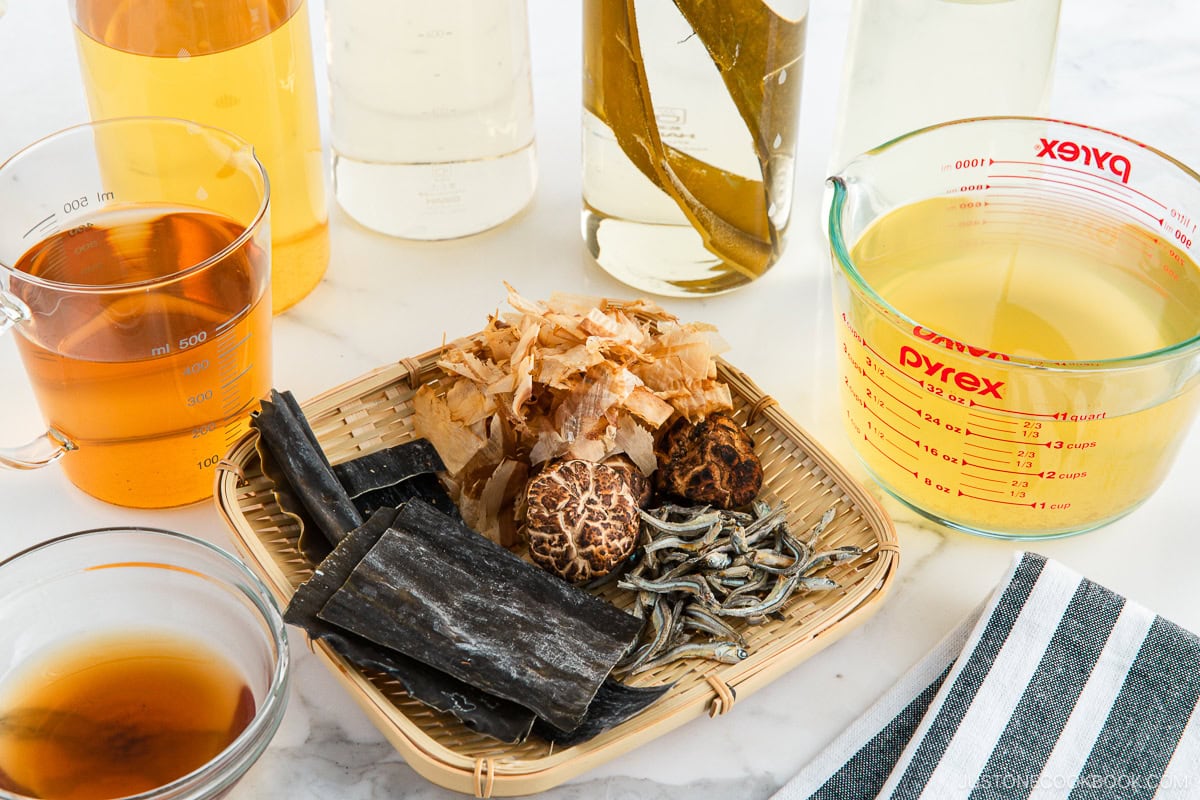
Recipes Using Katsuo Dashi
For an umami flavor, you can swap katsuo dashi in recipes like miso soup, ramen broth, udon noodles, nimono, and dipping sauce. Below are Japanese food recipes that specifically call for katsuo dashi:
The Ultimate Dashi Guide
Dashi is the master flavor enhancer in Japanese cooking, so you don’t need to season the food with too much salt, fat, and sugar. Its function is as indispensable as cooking oil, so anyone who is keen to cook authentic Japanese dishes at home will have to get started with dashi.
There are six different types of dashi you can use in Japanese cooking, including vegetarian and vegan dashi (*).
- Awase Dashi – a stock made from a combination of dried kelp + bonito flakes
- Kombu Dashi * – a stock made from dried kelp
- Katsuo Dashi – a stock made from dried bonito flakes
- Iriko Dashi – a stock made from dried anchovies/sardines
- Shiitake Dashi * – a stock made from dried shiitake mushrooms
- Vegan Dashi * – a stock made from dried shiitake mushrooms and kombu
If you are new to different types of dashi, check out my Ultimate Dashi Guide.
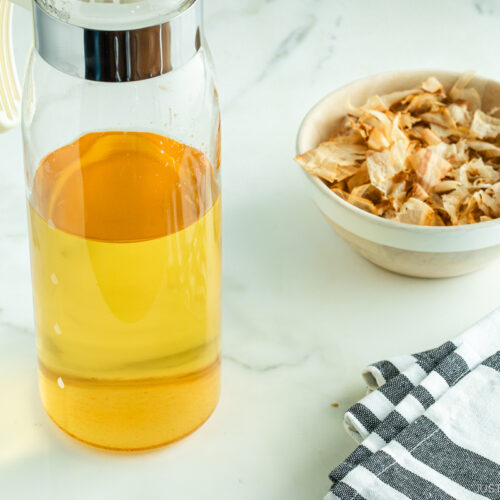
Katsuo Dashi (Bonito Stock)
Video
Ingredients
- ⅔ oz katsuobushi (dried bonito flakes) (2 cups; packed)
- 4 cups water
Instructions
- Gather all the ingredients.
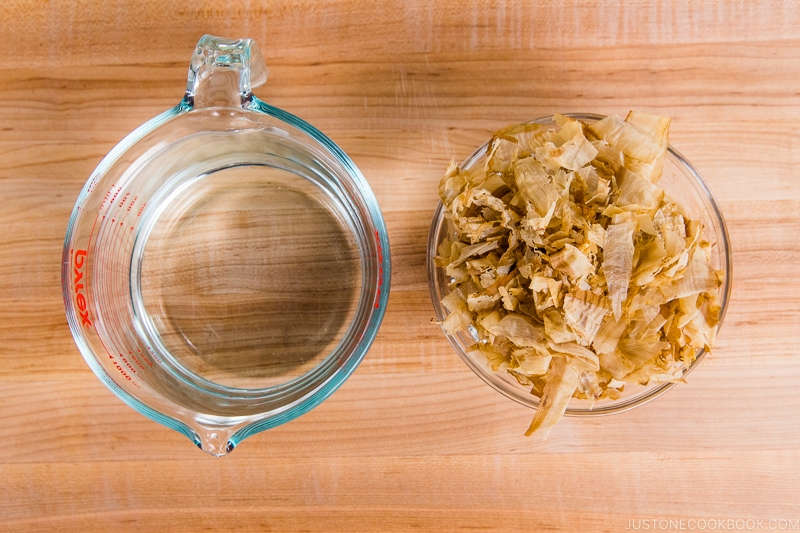
- In a medium pot, bring 4 cups water to a boil.
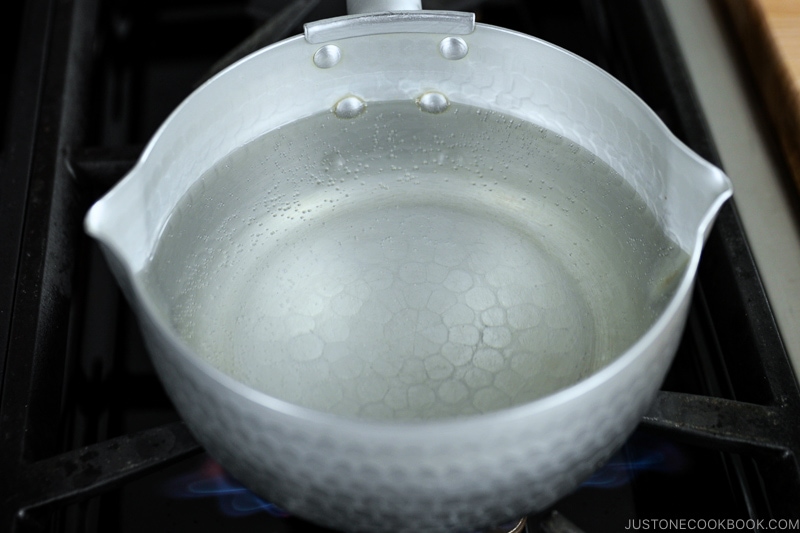
- Just before the water starts boiling, add ⅔ oz katsuobushi (dried bonito flakes) and bring it to a boil again, skimming occasionally.
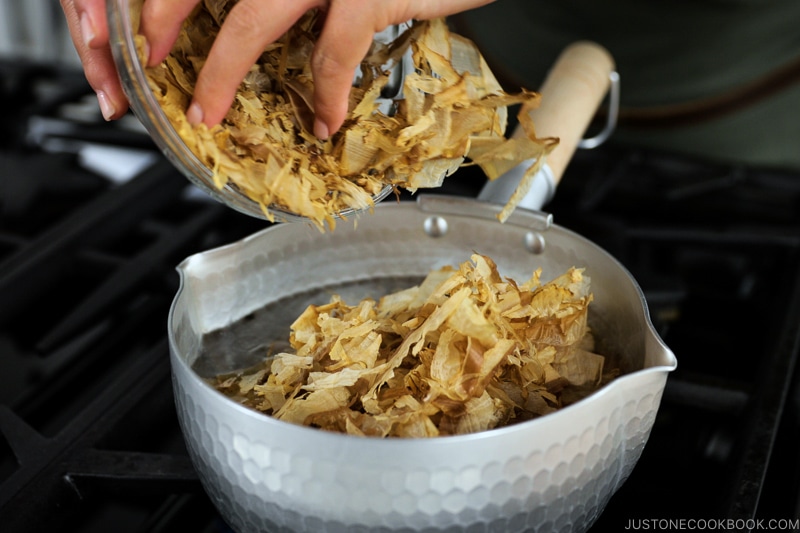
- Once the water is boiling, reduce the heat, simmer for just 30 seconds, and turn off the heat.
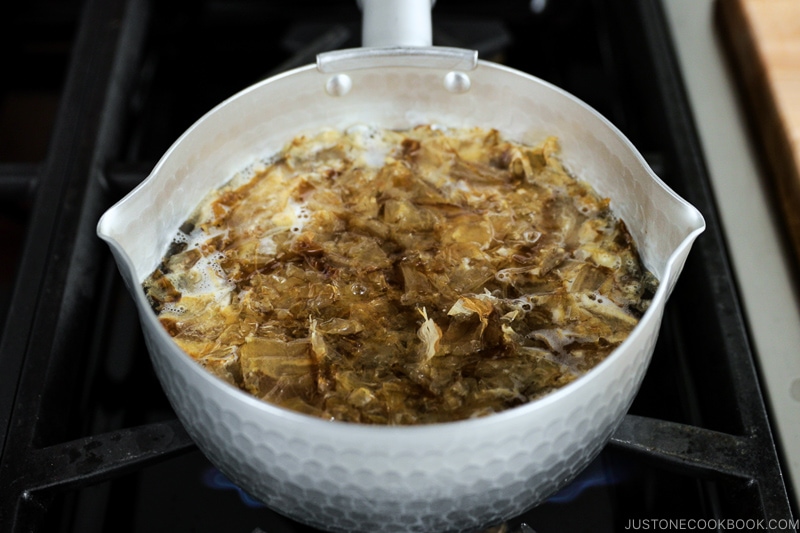
- Let the katsuobushi sink to the bottom, about 10 minutes.
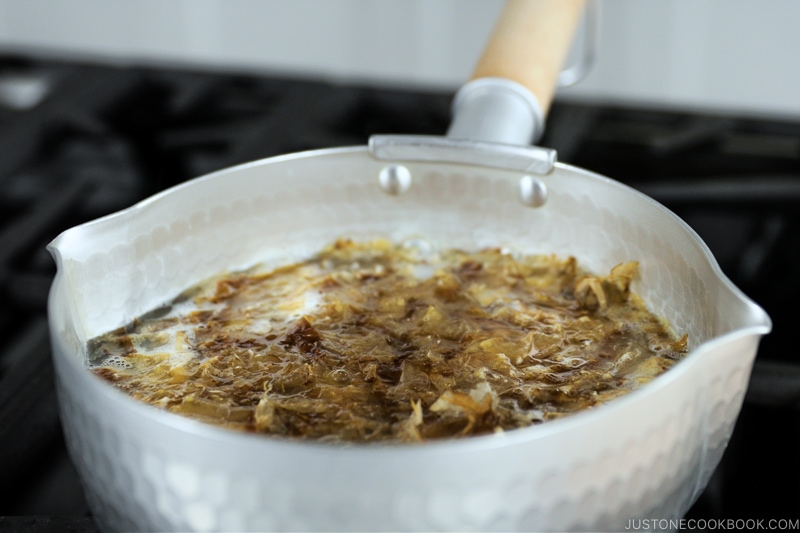
- Strain the dashi through a fine-mesh sieve over a bowl or measuring cup (reserve the spent katsuobushi and see below for what to do with it). Your Katsuo Dashi is ready to use.
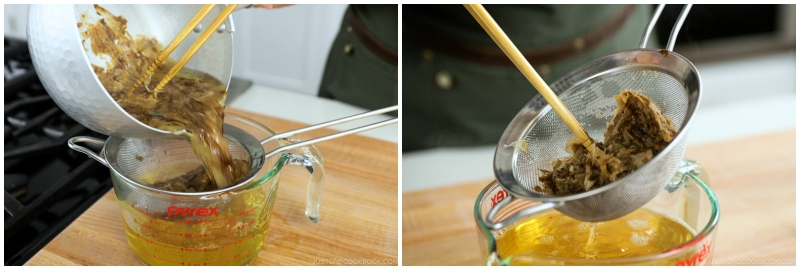
To Store
- If you are not using the dashi right away, store the dashi in a bottle or mason jar and keep in the refrigerator for 3–5 days or in the freezer for 2 weeks.
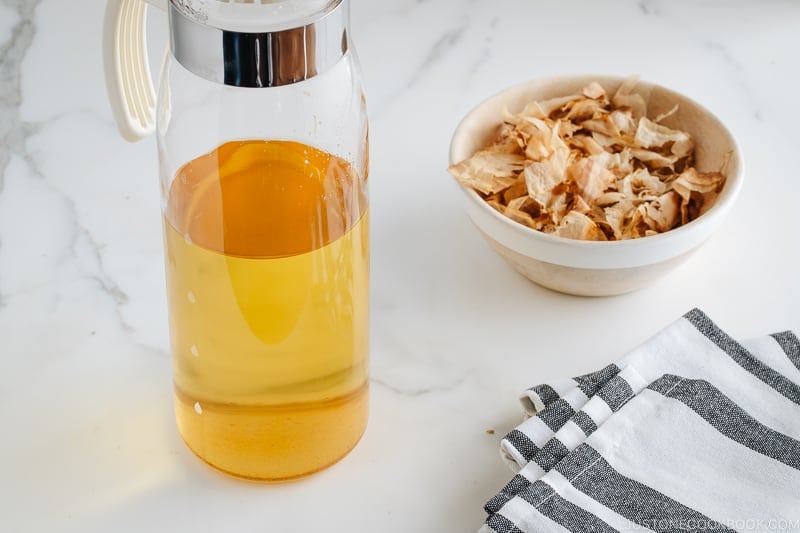
What to Do with Used Katsuobushi
- Save the drained katsuobushi to make Homemade Furikake rice seasoning. If you don‘t use it right away, you can freeze it for 2–3 weeks.
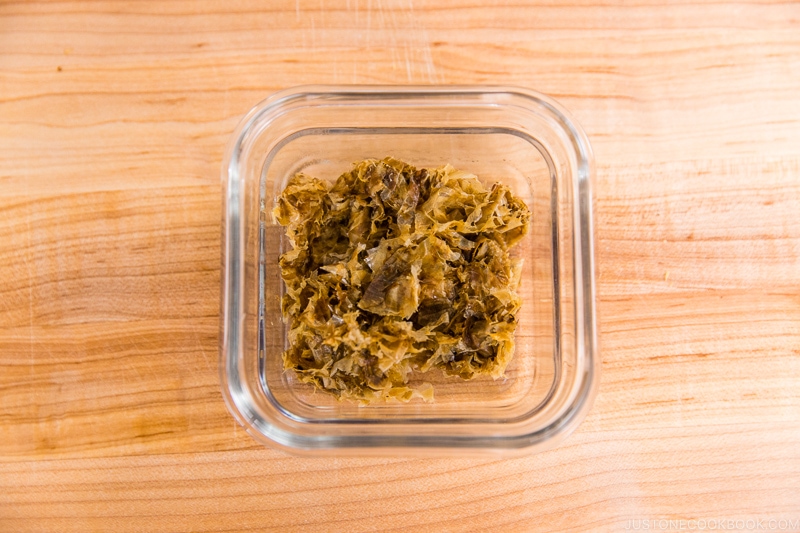
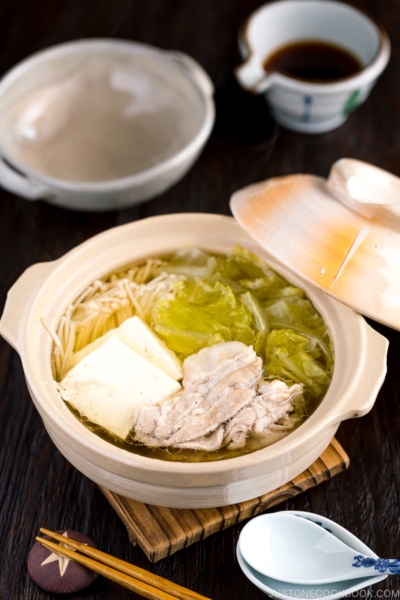
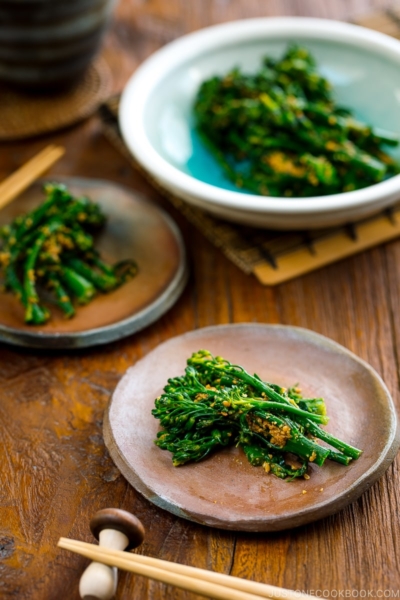
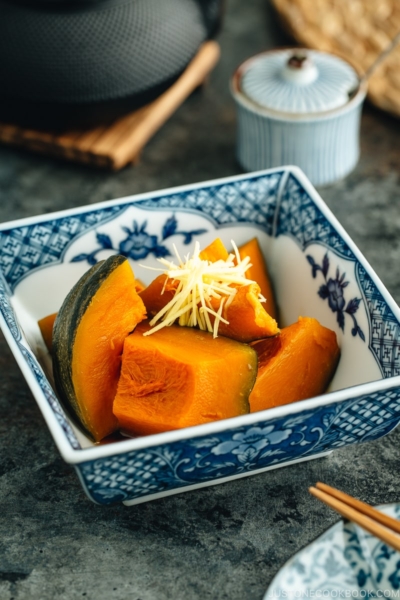
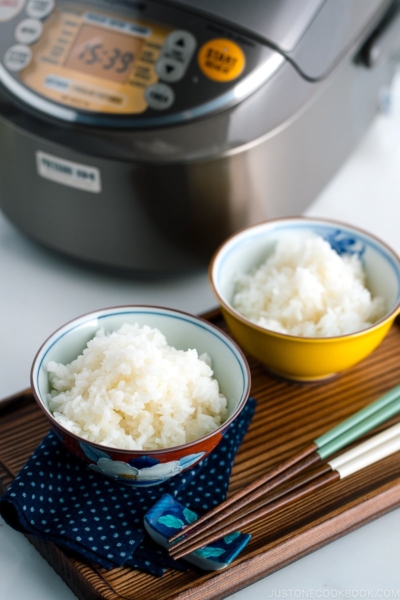




What is the glass pitcher that you use? I’m trying to find a nice way to store my kombu dash in my fridge. Thanks!
Hi X T! Thank you for reading Nami’s post.
Nami uses a glass pitcher from Hario. You can view it at this link. (Under Kitchen Tools)
https://www.amazon.com/shop/justonecookbook
We hope this helps!
Hi, I was wondering… I bought a bag of katsuobushi and it says “use within 7 days after opening”.
Is it really that short? What happens after the 7 days? Do they go wrong or just start loosing the taste?
It’s a big bag and I don’t know what to do with that amount in 7 days, since we are only two and eat it in moderation.
Thank you 🙏
Hi orfeo! Katsuobushi is extremely sensitive to humidity.
You can read more about how to store it, but in your case, freezing is the best option.
https://www.justonecookbook.com/dried-bonito-flakes-katsuobushi/
We hope this helps!
Hi Namiko, The way I usually make dashi is to put the bonito flakes, and kombu in a big jar, fill with pure water and put in the fridge overnight. Them just strain it and make miso soup. BUt I want some quick dashi now for tonights dinner. I did what you said, dropped the bonito in water that had boiled. Can I just let it sit there for a while before I drain it ? Will that ruin the taste ?
Hi Surati! Thank you for reading Nami’s post and trying her recipe!
You can let it sit for about 10 minutes as directed.
We usually don’t recommend leaving it for more than 10 minutes because the Dashi will have a strong smell and the flavor will be bitter.
We hope this helps!
Thank you so very much for this fantastic recipe and the very organized description of the different dashi!
I was wondering what kind of ramens use katsuo dashi? Sometimes I see recipes online that say “fish stock”, but I would love to know if this means niboshi, katsuo, or both?
どうもありがとうございます!
Hi ブロンズ🥉, Thank you for reading Nami’s post and for your kind feedback!
Katsuo Dashi may be used for different Ramen recipes. The Ramen broths are very complex, so it depends on the recipes.
For Nami’s Shio Ramen recipe, She used both Niboshi and Katsuo.
https://www.justonecookbook.com/shio-ramen/
And for Vegetarian Miso Ramen, She used Katsuo and Kombu.
https://www.justonecookbook.com/vegetarian-ramen/
To view Nami’s easy ramen recipes, please check this link; https://www.justonecookbook.com/#search/q=ramen
We hope this helps!
Wow, thank you for your apt reply! This is very helpful! I have been absolutely loving your recipes! Your attention to detail is so appreciated.
You are very welcome, ブロンズ! Nami and all of us at JOC are so happy to hear you enjoy the recipes and everything else that we share. It means so much to us.💞
Happy Cooking!
Is it possible to make nikujaga using katsuo dashi only if I don’t have kombu? Or better just switch it with water instead? Thank you
Hi Mey! Yes, you can use Katsuo Dashi only for Nikujaga.
Thank you very much for trying many of Nami’s recipes!☺️
Hi Nami,
Can you make niban dashi out of used katsuoboshi before I trun the to furikake?
Just want to make the most of it as it is quite expensive here in my country.
Thanks
Ira
Hi Ira, Thank you very much for trying Nami’s recipe!
Yes, you can make Niban-Dashi from this used Katsuobushi. Please add 5g of Katsuobushi to used Katuobushi for better taste. We hope this helps!
A very weak stock. This ruined 20g of good bonito flakes. Lesson learned: don’t run through a glossy recipe when the back of the pack can suffice. Their instructions 20g/500ml. Follow that and cut with filtered water to your liking.
Reference: Wadakyu (most popular brand in the world).
Brutal. Be warned.
Hi N.URIO, Thank you very much for trying this recipe.
We are very sorry that this didn’t meet your expectation.😔 Nami used to have double the amount of Katsuobushi in this recipe but adjusted and scaled back due to readers’ feedback (too fishy, too expensive).
Please feel free to adjust the amount for your liking.
I do not know a lot about katsuobushi. I purchased a large bag and made my stock like usual but the flavor was way to smoky compared to my previous attempts. Are some brands of katsuobushi smokier than others???? I feel that only one cup packed is enough for four cups of liquid.
Hi Marge, Yes. They are many different types of Katsuobushi.
It depends on the processing method making different types the flavor will also be distinct.
If you click the Katsuobushi in this recipe (ingredient list), it will take you to the link where Nami explains more about Katsuobushi types. or click here; https://www.justonecookbook.com/dried-bonito-flakes-katsuobushi/
We hope this helps, and please feel free to adjust the amount of Katsuobushi for your liking. 😉
The flavor feels super watered down! I feel i should’ve used less water or more bonito.
Hi A,
Thank you very much for trying this recipe!
It depends on Katsuobushi, and some may have less flavor or umami. Please feel free to add more bonito. You may also soak the Katsuobushi a little longer.
We hope this helps!
What is the white pot you’re using in your pictures? It’s beautiful!
Hi Elisa! It’s this pot: https://amzn.to/2A4JXwu
You can find all my favorite cooking products here: https://www.amazon.com/shop/justonecookbook